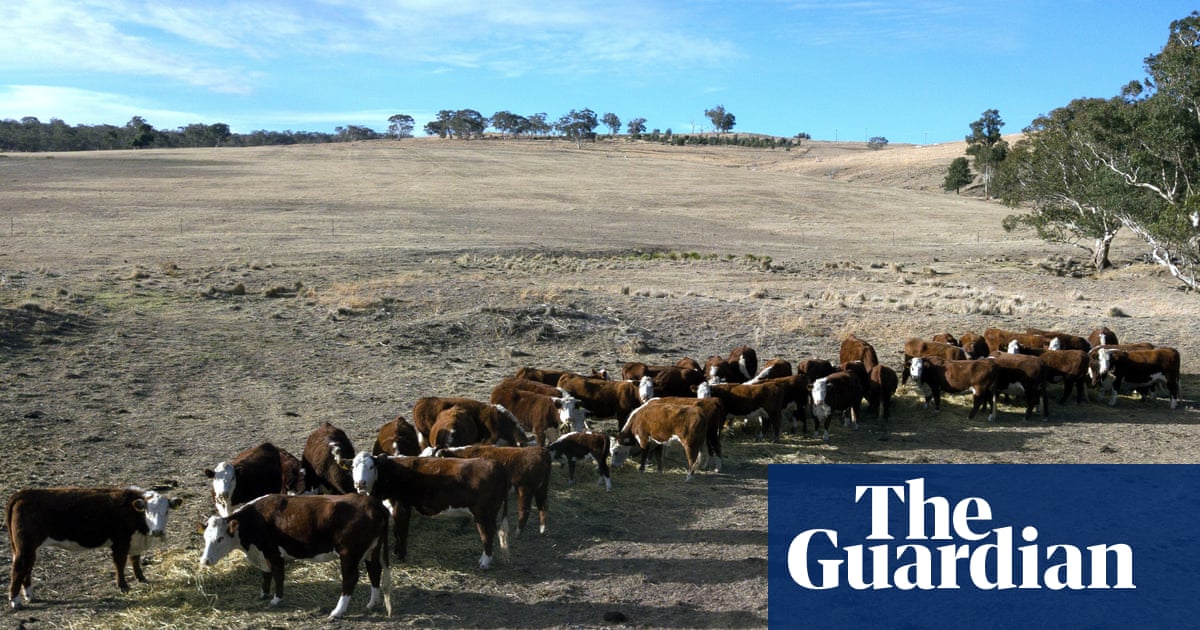While parts of Australia battle floods, farmers in the south are selling off stock, abandoning crops and pleading for help as drought deepens.
Farmer Paul Manwaring has been living in the shadow of rain.
The cattle breeder has watched for months as promising forecasts disappear, while the occasional shower creates patches of growth on the parched plains around Cootamundra, in south-westernNew South Wales.
Sign up for Guardian Australia’s breaking news email
“It’s all green where a storm went through, but 200 metres down the road it’s desolate,” Manwaring says.
The region is in the grips of disaster, according to the NSW drought indicator, part of a large area lit up in orange on the map.
Surrounding regions are also drying out, expected to slip into drought by mid-winter.
“[The rain] keeps either going north or south of us and we just keep being in that shadow,” Manwaring says.
After a hot summer, the mild and wet autumn break that farmers typically expect did not come. Scattered rain across parts of the district in recent days arrived too late – producers had already made tough decisions.
Manwaring, who runs a small livestock operation, sold his sheep in spring in anticipation of the dry, figuring that a run of good seasons would turn.
Others have had to pull up their crops, change their planting regimes or sell stock in a busy market, necessary moves that will affect farm incomes for years.
“Even when it does rain, it’s going to take a while to grow feed for all the livestock,” Manwaring says.
Much of southern Australia is in drought at the same timeas the NSW Hunter and mid-north coast regions face a major flood emergency, with five months’ rain falling there in two days.
April rainfall has been well below average across much of Victoria, Tasmania, southern NSW, easternSouth Australia, and the west coast and interior of Western Australia, according to the Bureau of Meteorology’s drought statement.
Tasmania recorded its driest April in a decade, with falls 50% below the 40-year average.
South Australia has also been hit particularly hard, with $2bn wiped from the state’s economy after the worst harvest in 15 years.
Cassie Oster, whose family runs a grazing and cropping operation at Jabuk, about 150km south-east of Adelaide, says producers on the marginal country are always prepared for dry conditions.
But this drought is particularly brutal.
“We are at a point where we’re like ... this is really scary,” Oster says.
“The decisions we’re having to make are things that we’ve never been faced with before.”
The family has sold off more than 1,000 sheep and abandoned several crops.
Those kinds of decisions make it harder for farmers to buy back into the market after the drought breaks, when they are also likely to face higher costs of inputs, machinery and fuel.
Drought conditions have been slowly creeping in since early 2023, mostly in regions with western-facing coastlines.
Dry periods have been historically linked to the El Niño climate pattern, but Australian scientists have identified more nuance in what triggers low rainfall.
Droughts develop when weather systems that lift and carry moisture from the ocean disappear, a recent scientific review found.
Sign up toBreaking News Australia
Get the most important news as it breaks
after newsletter promotion
That has been the case for months across the south, with slow-moving high pressure systems dominating and bringing warm and dry conditions with them.
There has been a long-term shift towards drier conditions in southern Australia, according to the weather bureau’s 2024 climate change report.
As the dry takes hold and forecasts fail to offer any certainty, farming groups have been calling for greater drought awareness and support.
Oster is one of many farmers backing a petition for a formal drought declaration to unlock emergency funds, something the SA government says it cannot do under a federal agreement.
She said the national drought plan, which aims to make farmers financially self-reliant, is all very well in a typical scenario.
Most farmers spend the good years preparing for the bad, but the last few seasons have made that nearly impossible.
“It’s like no other drought we’ve ever seen,” Oster says.
The Victorian Farmers Federation has urged politicians to spend more time in the regions.
“Mental health is a huge concern: when farmers feel isolated, unsupported and forgotten, the consequences can be devastating for individuals and entire communities,” president, Brett Hosking, says.
Eileen Jorgensen, who has spent a lifetime farming in Victoria, has noticed growers becoming more open about the mental toll of drought.
But distressed farmers talking to each other could only help for so long, she says.
“That is probably the darker side of the drought,” Jorgensen says, as looked out the window at her drying paddocks in the Wimmera region, in the state’s west.
The Jorgensens, who grow grain and raise sheep and Clydesdale horses, are able to keep their stock watered by the Wimmera Mallee pipeline that was built after successive droughts in the early 2000s.
But others further south are having to cart water and source increasingly expensive stock feed.
Jorgensen remains pragmatic, having grown up working in her father’s market garden watching bad seasons come and go.
“You just know it’s going to rain eventually,” she says.
“It may not be tomorrow, it may not be next month, but it will rain.”
In Australia, support is available atBeyond Blueon 1300 22 4636,Lifelineon 13 11 14, and atMensLineon 1300 789 978. In the UK, the charityMindis available on 0300 123 3393 andChildlineon 0800 1111. In the US, call or textMental Health Americaat 988 or chat 988lifeline.org.
